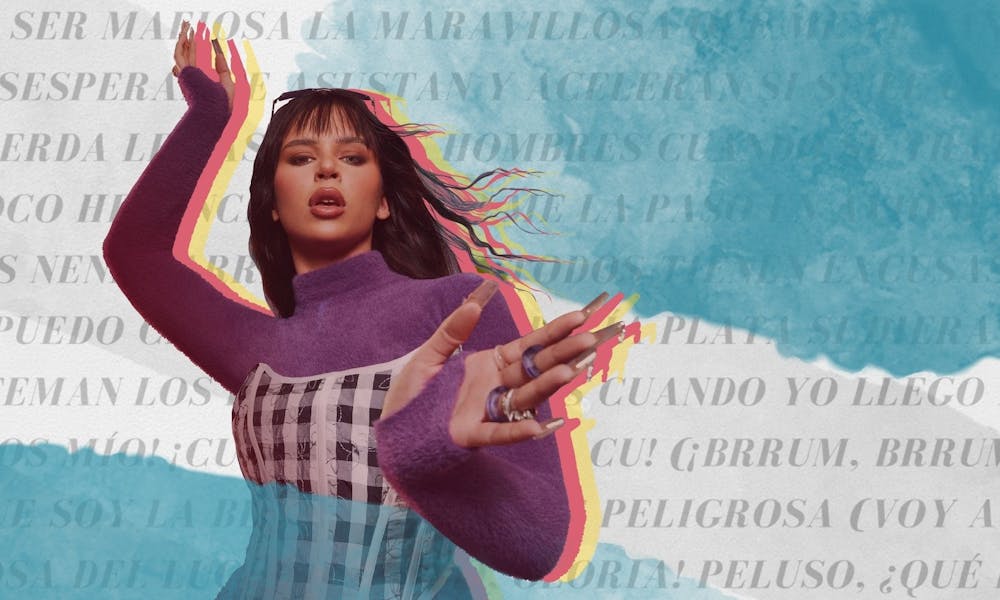Last year, the Spain–based Argentinian singer and rapper Nathy Peluso blew up on Twitter after an appearance on “A COLORS SHOW,” where she sang “SANA SANA.” To call the performance lively is an understatement; it showcases her eccentric performance style in the best way possible. Soon, users began to share clips of the video to poke fun at her outlandish performance style, referring to her as “hip–hip–hoppa girl” based on the song’s chorus. The video demonstrates the aspects that set Peluso apart in the way she uses performance to convey her artistic persona.
Despite receiving some criticism, the popularity of the performance is a clear indication of Peluso’s growing recognition—but she is more than just a viral twitter meme. Following the release of her debut album, Calambre, Peluso is poised to break the glass ceiling and achieve success as a female Latin artist. Latin Americans around the world are united by popular forms of Latino sound, such as reggaetón and trap. Nonetheless, with an appreciation of these genres comes the recognition that the space frequently promotes problematic themes—namely misogyny and the glorification of drugs—and is largely male–dominated.
Recently, female artists—such as Karol G and Becky G—have challenged these trends and risen to the top, becoming some of the most well–known artists in the space among their male peers. To achieve this, many of their strategies have been to serve as counterparts to major male names, such as Bad Bunny and J Balvin, perpetuating similar controversial tropes in reggaetón. Through her fresh sound and empowering lyrics, Peluso is paving the way to success on her own terms, without advancing these contentious topics. Her songs range from expressing nostalgia for her native country to brazenly singing about her own desires and sexuality.
The release of her debut album, Calambre, was followed by critical acclaim. In 2020, Peluso was recognized by the Recording Academy as a nominee for Best New Artist and Best Alternative song at the Latin Grammy Awards. This year, she received the same number of nominations as Bad Bunny, becoming a runner for Best Urban Fusion/Performance, Best Rap/Hip Hop Song, Best Alternative Music Album, and Best Alternative Song.
Although she is not a household name just yet, Peluso is well on her way. She has gained traction in Latin American and Spanish media, with features by major names such as Vogue and Glamour. Additionally, she has been securing recognition in major American media such as with the New York Times and The Late Show with Stephen Colbert. This is especially impressive, as only a handful of Latin artists achieve the feat of making it outside of the region. In Aug. 2021, Peluso was featured in a short video by Spotify’s emerging artist program, RADAR, in which she spoke about her story and her motivations as an artist.
In the video, she expresses how her love of music has grown since she was a child. She felt like she had no limits, listening to everything: “Brazilian music, tango, folklore, music that was very minimalist—adult music.” Evidently, this passion and openness towards different genres continues to influence her today.
As heard on Calambre and her most recent releases, “MAFIOSA” and “Ateo” with C. Tangana, Peluso’s sound is eclectic. She has an impressive number of multiple genres often found in Latin music at her disposal, and she fuses all of them to create a unique sound.
She is not defined solely by rap, reggaetón, tango, or pop; perhaps her most defining feature is her ability to seamlessly navigate through genres and personas. In Calambre, the music fully transforms from one song to the other—she goes from incorporating pop, R&B, and jazz elements in “BUENOS AIRES,” to fusing hip–hop and trap in “DELITO,” to working with a classic salsa beat on “PURO VENENO.”
Through this ability, Peluso effectively proves her role as a jack of all trades. Rather than giving the impression that she hasn’t identified her sound, the presence of multiple genres in her music serves as a strength.
Shifts in her music occur well beyond her sound, venturing into her lyricism and performance. Throughout her debut album, Peluso goes from wondering why a potential lover failed to call on “LLAMAME” to assertively rapping about independence and confidence on “BUSINESS WOMAN.”
Peluso’s lyrics are decidedly suggestive. In “TRIO,” one of the tracks that steers towards trap, she daringly proposes a ménage à trois. Evidently, Peluso also uses her music to explore topics related to sexuality and desire. Nonetheless, the way she approaches the topic is markedly different from other artists in the genre.
Most reggaetón and trap songs retell a story listeners know all too well: a woman at a party whose physical attributes set her apart from the rest, perreo, the singer’s inner thoughts detailing everything he wants to do to her, and then—surprise!—him getting the girl. If told by a woman, the story tends to stay the same, simply from the other point of view. Even if the song is about something else—a serious relationship or a break–up—many elements tend to remain the same. No matter the topic, the tale is notoriously told from the perspective of the male gaze.
This is one of the key aspects that truly differentiates Peluso. She uses one of her most risqué songs—”TRIO”—to delve deeper into her own desires. Peluso sings to her lover about her fantasies, expressing herself without subscribing to the need to objectify any of the parties involved.
With her impressive ability to fuse genres and her commitment to explore bold topics through music, a Twitter meme is lowest on the list of interesting things about Peluso. As her recognition continues to grow, Nathy Peluso is an artist to look out for.







